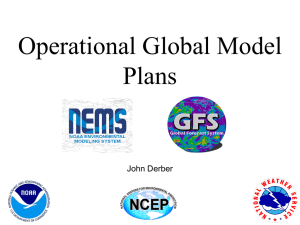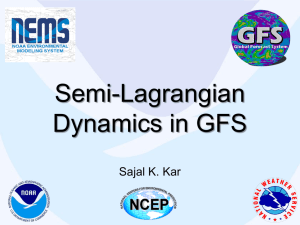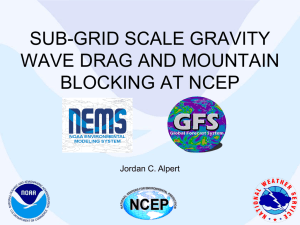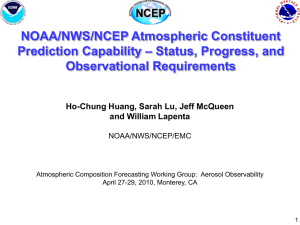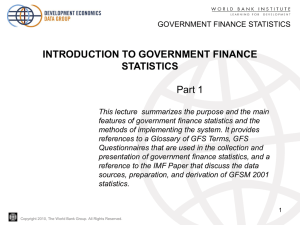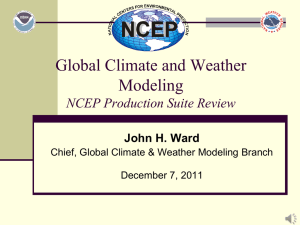02-Derber_GCWM - Department of Atmospheric and
advertisement
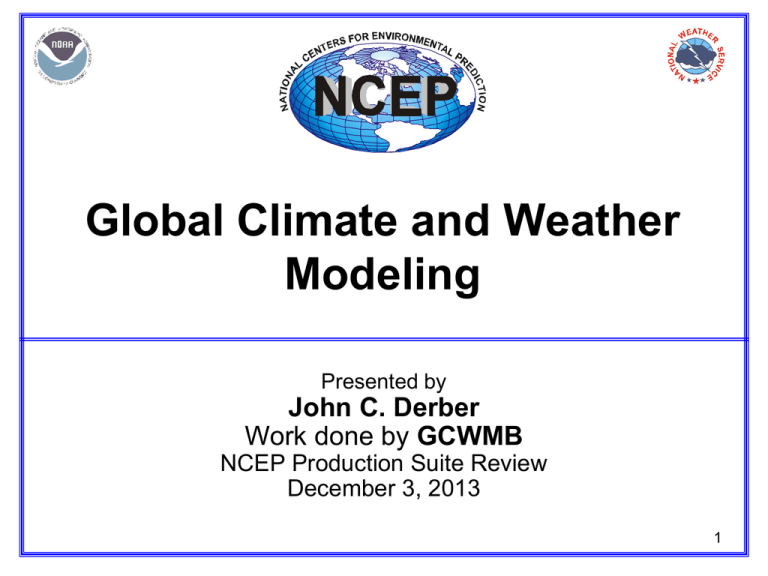
Global Climate and Weather Modeling Presented by John C. Derber Work done by GCWMB NCEP Production Suite Review December 3, 2013 1 NOAA’s NWS Model Production Suite Climate CFS Oceans Hurricane GFDL HWRF MOM3 HYCOM WaveWatch III 1.7B Obs/Day Satellites 99.9% Global Data Assimilation Global Forecast System Regional NAM WRF NMM Dispersion ARL/HYSPLIT Severe Weather Regional Data Assimilation WRF NMM/ARW Workstation WRF North American Ensemble Forecast System GFS, Canadian Global Model Short-Range Ensemble Forecast WRF: ARW, NMM ETA, RSM Air Quality NAM/CMAQ *Rapid Update for Aviation NOAH Land Surface Model For eca st 2 Outline • Global Climate and Weather Modeling Branch FY13 Upgrades • Completed WCOSS transition • Transitioning to new code management • • procedures Implementations • Data upgrade for assimilation system • WAFS grid upgrade GCWMB and Data Assimilation Plans • T1534L64 GFS/GDAS upgrade 3 Global Data Assimilation System Upgrade Implemented • Five additional satellite instruments: • Suomi NPP CrIS • • MetOp-B AMSU-A • MetOp-B MHS • MetOp-B GRAS • Meteosat-10 SEVIRI Most are in similar orbits to similar current satellite instruments 4 Configuration • For CrIS we receive a subset of 399 channels (Gambacorta et al., 2013) in BUFR format. We assimilate those channels designated for temperature, cloud, CO2 and surface that do not suffer from solar contamination. This totals 84 channels from 672.5cm-1 to 1095.0cm-1. • This is similar to our IASI channel selection. • For all other instruments (AMSU-A, MHS, SEVIRI, GRAS) we use the same configuration as for current operational equivalents. 5 Pre-Implementation Test Results • Compare three forecast/assimilation experiments • • • • GFS: Operations (mostly run on CCS) prcntrlt: A control run using the operational WCOSS configuration (WCOSS) prnurads: prcntrlt + radiance upgrades (WCOSS) Please note when interpreting these plots that the difference between WCOSS and CCS control runs are often larger than the signal from the new radiances. 6 Pre-Implementation Test Results 500 hPa Anomaly Correlation Scores: N. Hemisphere time-series 7 Pre-Implementation Test Results 500 hPa Anomaly Correlation Scores: S. Hemisphere time-series 8 Pre-Implementation Test Results 850hPa and 200hPa Tropical Vector Wind RMS Scores 850hPa 200hPa 9 Pre-Implementation Test Results CONUS Precip Skill Scores: F12-F36 10 Pre-Implementation Test Results CONUS Precip Skill Scores: F36-F60 11 Pre-Implementation Test Results CONUS Precip Skill Scores: F60-F84 12 Pre-Implementation Test Results Fit to Observations: Temperature (24 & 48hr fcsts) For all variables and forecast lengths – Little impact 13 Pre-Implementation Test Results Hurricane Scores for 2013 E. Pacific Basin Similar results for other basins. Insufficient sample, but data not available for previous seasons. 14 Outline • Global Climate and Weather Modeling Branch FY13 Upgrades • Completed WCOSS transition • Transitioning to new code management • • procedures Implementations • Data upgrade for assimilation system • WAFS grid upgrade GCWMB and Data Assimilation Plans • T1534L64 GFS/GDAS upgrade 15 WAFS grid upgrade • Additional levels added to WAFS file only • FL80 – t,u,v,q • FL210 – t,u,v,q • FL410 – t,u,v – original request • FL490 – t,u,v 16 Outline • Global Climate and Weather Modeling Branch FY13 Upgrades • Completed WCOSS transition • Transitioning to new code management • • procedures Implementations • Data upgrade for assimilation system • WAFS grid upgrade GCWMB and Data Assimilation Plans • T1534L64 GFS/GDAS upgrade 17 Next Implementation – Q4FY14 • Schedule Outline – – – – – – Configuration Finalized Tuning and initial testing completed EMC retrospective testing begins Real-Time Evaluation begins through NCO feed Real-Time Evaluation Ends Implementation 11/25/2013 12/31/2013 01/06/2014 • Status – – – – Configuration Finalized • GEFS upgrade separated from GDAS/GFS upgrade 2 Major (maybe just 1) issues • Loss of ozone • Warm surface temperatures Risks • Testing timetable • Science uncertainties Downstream users have been given early access to output files. NCO has modifications to their processing under development 18 Model Highlights • • • • T1534 Semi-Lagrangian (~13km) Use of high resolution daily SST and sea ice analysis High resolution until 10 days Physics – – – – – – – Cloud estimate modifications Radiation modifications Reduced drag coefficient at high wind speeds Stationary convective gravity wave drag Consistent GFS diagnosis snow accumulation in post and model Compute and output frozen precipitation fraction Land Surface • Soil Moisture climatology from CFSv2 • Changes to roughness length calculations 19 Post - Processer Highlights • Faster/less memory version • .25 degree post file instead of master grib file (GRIB2) • Accumulation bucket changed from 12 hour to 6 hour between day 8 and day 10 • Add user requested fields – – – – – – frozen precipitation fraction ozone at 150, 200, 250, 300, 350, and 400 mb, 2m dew point, wind chill and heat index, instantaneous precipitation type membrane SLP in GDAS pgb files • Update BUFR station list to NAM/GFS list 20 Analysis Highlights • Structure • T574 analysis for T1534 deterministic • Single scale background error (for efficiency) • Code optimization • Observations – GPSRO enhancements – Updates to radiance assimilation • • • • Assimilate SSM/IS UPP LAS data CRTM v2.1.3 New bias correction Additional satwind data – hourly GOES, EUMETSAT • EnKF modifications – Stochastic physics in EnKF forecasts – T574L64 EnKF ensembles 21 GCWMB Plans • GEFS – Unification with global system • GFS – NEMS – Higher horizontal and vertical resolution for GFS/GEFS – ~ T2000L128 – Enhanced Physics • • • • Convection Clouds Boundary Layer Etc. – Non-hydrostatic • Analysis – 4D – Hybrid – Improved use of observations • • • • • Inclusion of cloudy radiances Bias correction of aircraft data Etc. Whole Atmosphere Model (w SWPC) Enhanced NGAC 22 Status update on Whole Atmosphere Model (WAM) -Joint efforts from EMC and SWPC - Direct support space weather service as planed in NWS Weather Ready Nation Roadmap (P39, WRN Roadmap Version 2.0-April 2013) - Personnel: Jun Wang, Miodrag Rancic Henry Juang, Shrinivas Moorthi, Yu-tai Hou, Mark Iredell, Sarah Lu, John Derber, Fanglin Yang (EMC) Rashid Akmaev, Tim Fuller-Rowell, Fei Wu, Houjun Wang (SWPC) Whole Atmosphere Model Completed Dynamics and physics updates in NEMS WAM model as of Nov 2013 Thermodynamics equation was revisited, two major updates on the enthalpy vertical flux terms have been done. Eighth order horizontal diffusion is added. The impact of Rayleigh damping is investigated. Non-iteration Dimensional-split Semi-Lagrangian (NDSL) dynamical core for WAM is developed. New RRTM-McICA radiation package is added, the new radiation has sub-grid cloud treatment with additional improvement in cloud radiative property scheme, no major impacts are anticipated. A scale parameter in gravity wave drag is set to be same as operational setting. WAM dry convective adjustment routine has been updated to remove the temperature instability near the model top layers WDAS – Whole atmosphere model Data Assimilation System The neutral atmosphere component of the coupler Integrated Dynamics through Earth’s Atmosphere (IDEA) model is built in GFS general circulation model Model is ported in NEMS ESMF frame work Vertical level is extended to 150, near a nominal altitude 600km It has Eulerian dynamics core, general hybrid coordinate with enthalpy as thermodynamic prognostic variable IDEA physics is coupled in GFS physics Model has Reasonable upper atmosphere temperature and runs stable Model baseline has been set up A cycling system with data assimilation and model forecast, post processing, verification and archive is close to finish c b d Fig 1. Westward-propagating Diurnal tide with zonal Fig 2.Average January cross section of wavenumber 1 (DW1), Eastward-Propagating Diurnal tide (a)zonal mean temp(b)zonal mean zonal with zonal wavenumber 3 (DE3), Westward-Propagating wind(c)zonal mean ozone(d)zonal mean Semi-diurnal tide with zonal wavenumber 2 (SW2) meridional wind NEMS WAM reproduces the seasonal variability of tides Results are close to SPARC remarkably well compared to SABER observation observation data Future plan WDAS is derived by a vertical extension of Grid-point Statistical Interpolation (GSI) data assimilation system used for assimilation of data in GFS Current Status a Starting parallel cycling run Upgrading NEMS WAM model to the latest GFS code Reaching out to potential WAM products users Preparing project chart for operational implementation Timeline for FY14 Q1FY14: NEMS WAM parallel run starts to run Target to be implemented in Q1FY15 NEMS GFS Aerosol Component (NGAC): NCEP’s global aerosol forecast system From NGAC website Model Configuration: Forecast model: Global Forecast System (GFS) based on NOAA Environmental Modeling System (NEMS), NEMS-GFS Aerosol model: NASA Goddard Chemistry Aerosol Radiation and Transport Model, GOCART Near-Real-Time Dust Forecasts Global dust-only guidance was established in Q4FY12 5-day dust forecast once per day (at 00Z), output every 3 hour, at T126 (~ 1 deg) L64 resolution Contribute global multi-model ensemble (by International Cooperative for Aerosol Prediction, ICAP) and regional multi-model ensemble (by WMO Sand and Dust Storm Warning Advisory and Assessment System, SDS-WAS) ICAP MME 24
